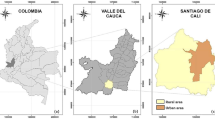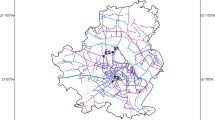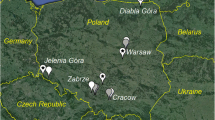Abstract
Purpose
This study presents a procedure to differentiate the local and remote sources of particulate-bound polycyclic aromatic hydrocarbons (PAHs).
Methods
Data were collected during an extended PM2.5 sampling campaign (2009–2010) carried out for 1 year in Venice-Mestre, Italy, at three stations with different emissive scenarios: urban, industrial, and semirural background. Diagnostic ratios and factor analysis were initially applied to point out the most probable sources. In a second step, the areal distribution of the identified sources was studied by applying the discriminant analysis on factor scores. Third, samples collected in days with similar atmospheric circulation patterns were grouped using a cluster analysis on wind data. Local contributions to PM2.5 and PAHs were then assessed by interpreting cluster results with chemical data.
Results
Results evidenced that significantly lower levels of PM2.5 and PAHs were found when faster winds changed air masses, whereas in presence of scarce ventilation, locally emitted pollutants were trapped and concentrations increased. This way, an estimation of pollutant loads due to local sources can be derived from data collected in days with similar wind patterns. Long-range contributions were detected by a cluster analysis on the air mass back-trajectories. Results revealed that PM2.5 concentrations were relatively high when air masses had passed over the Po Valley. However, external sources do not significantly contribute to the PAHs load.
Conclusions
The proposed procedure can be applied to other environments with minor modifications, and the obtained information can be useful to design local and national air pollution control strategies.



Similar content being viewed by others
References
Arey J, Atkinson R (2003) Photochemical reactions of PAHs in the atmosphere. In: Douben PET (ed) PAHs: an ecotoxicological perspective. Wiley, Chichester, pp 47–63
Boström CE, Gerde P, Hanberg A, Jernström B, Johansson C, Kyrklund T, Rannug A, Törnqvist M, Victorin K, Westerholm R (2002) Cancer risk assessment, indicators, and guidelines for polycyclic aromatic hydrocarbons in the ambient air. Environ Health Perspect 110:451–488
Callén MS, de la Cruz MT, López JM, Murillo R, Navarro MV, Mastral AM (2008) Long-range atmospheric transport and local pollution sources on PAH concentrations in a South European urban area. Fulfilling of the European Directive. Water Air Soil Pollut 190:271–285
Contini D, Genga A, Cesari D, Siciliano M, Donateo A, Bove MC, Guascito MR (2010) Characterisation and source apportionment of PM10 in an urban background site in Lecce. Atmos Res 95:40–54
Contini D, Gambaro A, Belosi F, De Pieri S, Cairns WRL, Donateo A, Zanotto E, Citron M (2011) The direct influence of ship traffic on atmospheric PM2.5, PM10 and PAH in Venice. J Environ Manage 92:2119–2129
Darby L (2005) Cluster analysis of surface winds in Houston, Texas, and the impact of wind patterns on ozone. J Appl Meteorol 44:1788–1806
Draxler RR, Rolph GD (2011) HYSPLIT (HYbrid Single-Particle Lagrangian Integrated Trajectory) Model, NOAA Air Resources Laboratory, Silver Spring. http://ready.arl.noaa.gov/HYSPLIT.php
Draxler R, Stunder B, Rolph G, Stein A, Taylor A (2009) HYSPLIT4 User's Guide version October 2009. http://www.arl.noaa.gov/documents/reports/hysplit_user_guide.pdf
Durant J, Busby W, Lafleur A, Penman B, Crespi C (1996) Human cell mutagenicity of oxygenated, nitrated and unsubstituted polycyclic aromatic hydrocarbons associated with urban aerosols. Mutat Res-Genet Tox 371:123–157
Dvorská A, Lammel G, Klánová J (2011) Use of diagnostic ratio for studying source apportionment and reactivity of ambient polycyclic aromatic hydrocarbon over Central Europe. Atmos Environ 45:420–427
EC - European Commission (2001) Ambient air pollution by polycyclic aromatic hydrocarbons (PAH). Office for Official Publications of the European Communities, Luxembourg, Position paper
EC - European Commission (2004) Directive 2004/107/EC of the European Parliament and of the Council of 15 December 2004 relating to arsenic, cadmium, mercury, nickel and polycyclic aromatic hydrocarbons in ambient air. Off J Eur Union L23:3–16
Esteve W, Budzinski H, Villenave E (2006) Relative rate constants for the heterogeneous reactions of NO2 and OH radicals with polycyclic aromatic hydrocarbons adsorbed on carbonaceous particles. Part 2: PAHs adsorbed on diesel particulate exhaust SRM 1650a. Atmos Environ 40:201–211
European Environment Agency (2011) AirBase Website—The European air quality database. http://www.eea.europa.eu/themes/air/airbase
Fenner K, Scheringer M, MacLeod M, Matthies M, McKone TE, Stroebe M et al (2005) Comparing estimates of persistence and longrange transport potential among multimedia models. Environ Sci Technol 39:1932–1942
Galarneau E (2008) Source specificity and atmospheric processing of airborne PAHs: Implications for source apportionment. Atmos Environ 42:8139–8149
Katsoyiannis A, Sweetman AJ, Jones KC (2011) PAH Molecular diagnostic ratios applied to atmospheric sources: a critical evaluation using two decades of source inventory and air concentration data from the UK. Environ Sci Technol 45:8897–8906
Kaufmann P, Whiteman CD (1999) Cluster-analysis classification of wintertime wind patterns in the Grand Canyon region. J Appl Meteor 38:1131–1147
Kavouras IG, Koutrakis P, Tsapakis M, Lagoudaki E, Stephanou EG, Von Baer D, Oyola P (2001) Source apportionment of urban particulate aliphatic and polynuclear aromatic hydrocarbons (PAHs) using multivariate methods. Environ Sci Technol 35:2288–2294
ISPRA - Istituto Superiore per la Protezione e la Ricerca Ambientale (2005) Italian Disaggregated emission inventory 2005 Website. http://www.sinanet.isprambiente.it/it/inventaria/disaggregazione_prov2200/
Lee JY, Kim YP (2007) Source apportionment of the particulate PAHs at Seoul, Korea: impact of long range transport to a megacity. Atmos Chem Phys 7:3587–3596
Lee JH, Gigliotti CL, Offenberg JH, Eisenreich SJ, Turpin BJ (2004) Sources of polycyclic aromatic hydrocarbons to the Hudson River Airshed. Atmos Environ 38:5971–5981
Malcolm HM, Dobson S (1994) The calculation of an environmental assessment level (EAL) for atmospheric PAHs using relative potencies. HMIP-commissioned research. Department of the Environment, London
Manahan SE (2009) Environmental chemistry, 9th edn. CRC, New York
Manoli E, Kouras A, Samara C (2004) Profile analysis of ambient and source emitted particle-bound polycyclic aromatic hydrocarbons from three sites in northern Greece. Chemosphere 56:867–878
Mantis J, Chaloulakou A, Samara C (2005) PM10-bound polycyclic aromatic hydrocarbons (PAHs) in the Greater Area of Athens, Greece. Chemosphere 59:593–604
Masiol M, Rampazzo G, Ceccato D, Squizzato S, Pavoni B (2010) Characterization of PM10 sources in a coastal area near Venice (Italy): an application of factor-cluster analysis. Chemosphere 80:771–778
Moldanová J, Fridell E, Popovicheva O, Demirdjian B, Tishkova V, Faccinetto A, Focsa C (2009) Characterisation of particulate matter and gaseous emissions from a large ship diesel engine. Atmos Environ 43:2632–2641
Molinaroli E, Pistolato M, Rampazzo G, Guerzoni S (1999) Geochemistry of natural and anthropogenic fall-out (aerosol and precipitation) collected from the NW Mediterranean: two different multivariate statistical approaches. Appl Geochem 14:423–432
Nisbet C, LaGoy P (1992) Toxic equivalency factors (TEFs) for polycyclic aromatic hydrocarbons (PAHs). Regul Toxicol Pharmacol 16:290–300
Petry T, Schmid P, Schlatter C (1996) The use of toxic equivalency factors in assessing occupational and environmental health risk associated with exposure to airborne mixtures of polycyclic aromatic hydrocarbons (PAHs). Chemosphere 32:639–648
Pires JCM, Sousa SIV, Pereira MC, Alvim-Ferraz MCM, Martins FG (2008) Management of air quality monitoring using principal component and cluster analysis—Part I: SO2 and PM10. Atmos Environ 42:1249–1260
Putaud J-P, Van Dingenen R, Alastuey A, Bauer H, Birmili W et al (2010) A European aerosol phenomenology—3: physical and chemical characteristics of particulate matter from 60 rural, urban, and kerbside sites across Europe. Atmos Environ 44:1308–1320
Rampazzo G, Masiol M, Visin F, Pavoni B (2008a) Gaseous and PM10-bound pollutants monitored in three environmental conditions in the Venice area (Italy). Water Air Soil Pollut 195:161–176
Rampazzo G, Masiol M, Visin F, Rampado E, Pavoni B (2008b) Geochemical characterization of PM10 emitted by glass factories in Murano, Venice (Italy). Chemosphere 71:2068–2075
Ravindra K, Sokhi R, Van Grieken R (2008a) Atmospheric polycyclic aromatic hydrocarbons: source attribution, emission factors and regulation. Atmos Environ 42:2895–2921
Ravindra K, Wauters E, Van Grieken R (2008b) Variation in particulate PAHs levels and their relation with the transboundary movement of the air masses. Sci Total Environ 396:100–110
Riddle SG, Jakober CA, Robert MA, Cahill TM, Charles MJ, Kleeman MJ (2007) Large PAHs detected in fine particulate matter emitted from light-duty gasoline vehicles. Atmos Environ 41:8658–8668
Rogge WF, Hildemann LM, Mazurek MA, Cass GR, Simoneit BRT (1993) Sources of fine organic aerosol. 5. Natural gas home appliances. Environ Sci Technol 27:2736–2744
Rolph GD (2011) Real-time Environmental Applications and Display sYstem (READY) Website, NOAA Air Resources Laboratory, Silver Spring. http://ready.arl.noaa.gov
Squizzato S, Masiol M, Innocente E, Pecorari E, Rampazzo G, Pavoni B (2012) A procedure to assess local and long-range transport contributions to PM2.5 and secondary inorganic aerosol. J Aerosol Sci 46:64–76
Stohl A (1998) Computation, accuracy and applications of trajectories—a review and bibliography. Atmos Environ 32:947–966
Tamamura S, Sato T, Ota Y, Wang Z, Tang N, Hayakawa K (2007) Long-range transport of polycyclic aromatic hydrocarbons (PAHs) from the eastern Asian continent to Kanazawa, Japan with Asian dust. Atmos Environ 41:2580–2593
Wan X, Chen J, Tian F, Sun W, Yang F, Saiki K (2006) Source apportionment of PAHs in atmospheric particulates of Dalian: factor analysis with nonnegative constraints and emission inventory analysis. Atmos Environ 40:6666–6675
Acknowledgments
The authors acknowledge the financial support provided by Ente della Zona Industriale di Porto Marghera. The authors are very grateful to the local Environmental Protection Agency (ARPAV) managers and technicians for logistics, sampling and for the useful exchange of information. ARPAV-Centro Meteorologico di Teolo supplied part of weather data. The authors gratefully acknowledge having used the HYSPLIT transport and dispersion model compiled by the NOAA Air Resources Laboratory (ARL) and available in the READY website (http://www.arl.noaa.gov/ready.php).
Author information
Authors and Affiliations
Corresponding author
Additional information
Responsible editor: Leif Kronberg
Electronic supplementary material
Below is the link to the electronic supplementary material.
Online Resource 1
(DOCX 19 kb)
Online Resource 2
(DOCX 21 kb)
Online Resource 3
(DOCX 29 kb)
Online Resource 4
(DOCX 20 kb)
Online Resource 5
(DOCX 20 kb)
Online Resource 6
(DOCX 21 kb)
Rights and permissions
About this article
Cite this article
Masiol, M., Centanni, E., Squizzato, S. et al. GC-MS analyses and chemometric processing to discriminate the local and long-distance sources of PAHs associated to atmospheric PM2.5 . Environ Sci Pollut Res 19, 3142–3151 (2012). https://doi.org/10.1007/s11356-012-0858-4
Received:
Accepted:
Published:
Issue Date:
DOI: https://doi.org/10.1007/s11356-012-0858-4




